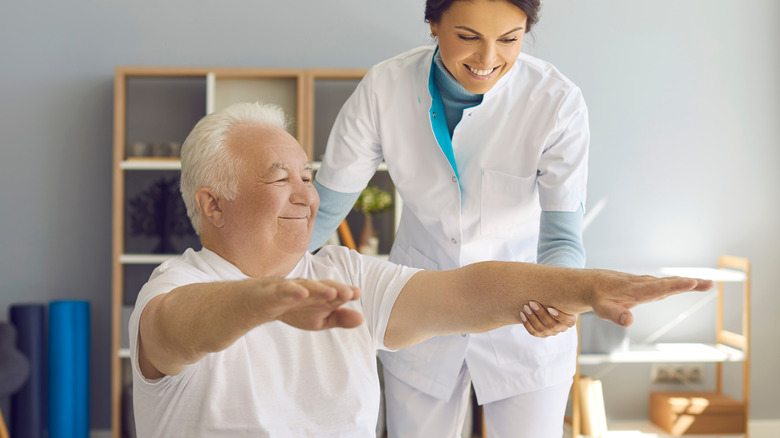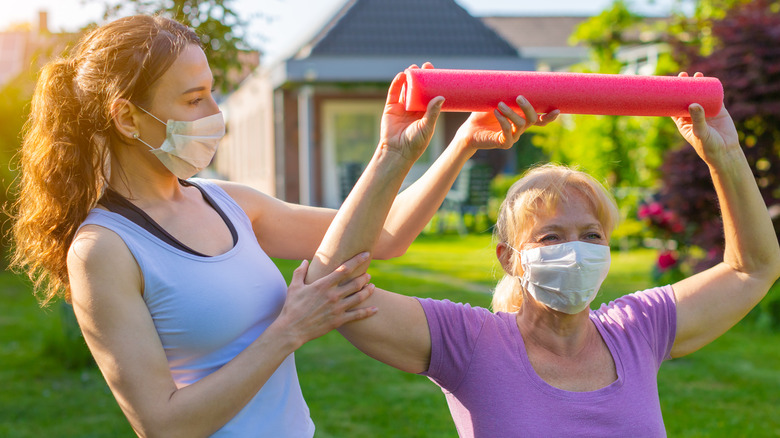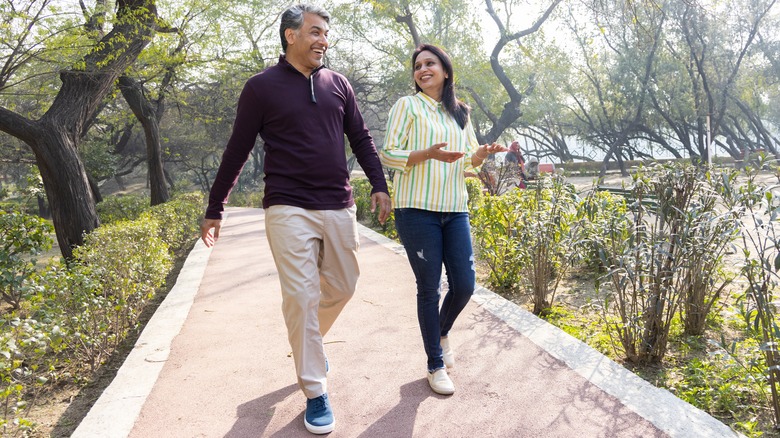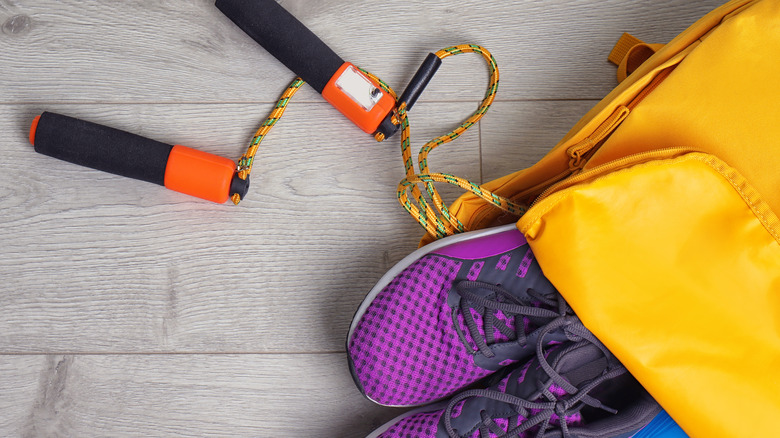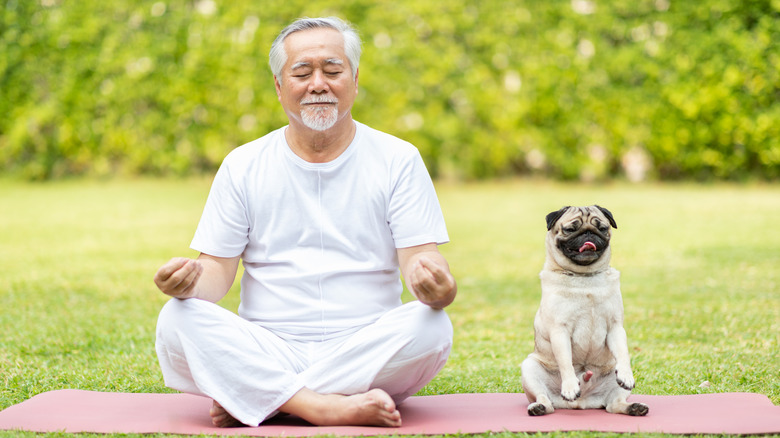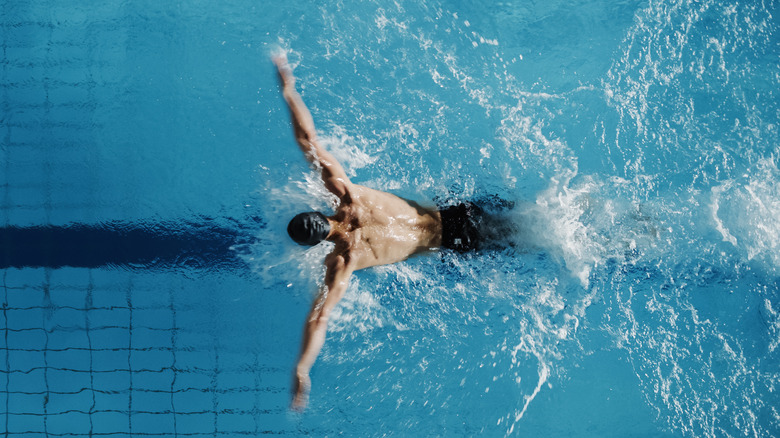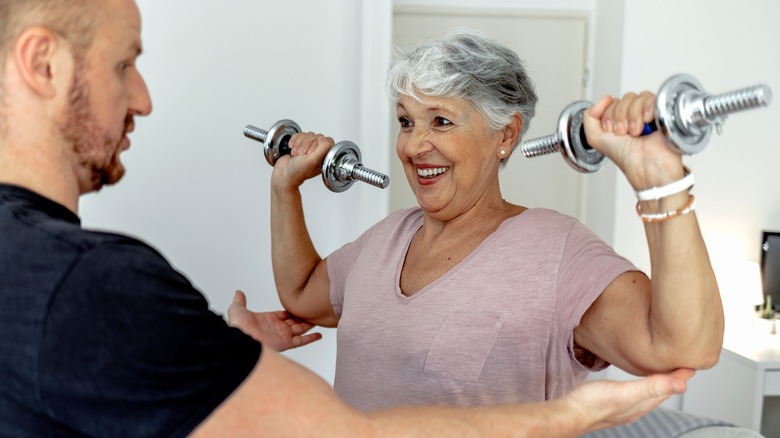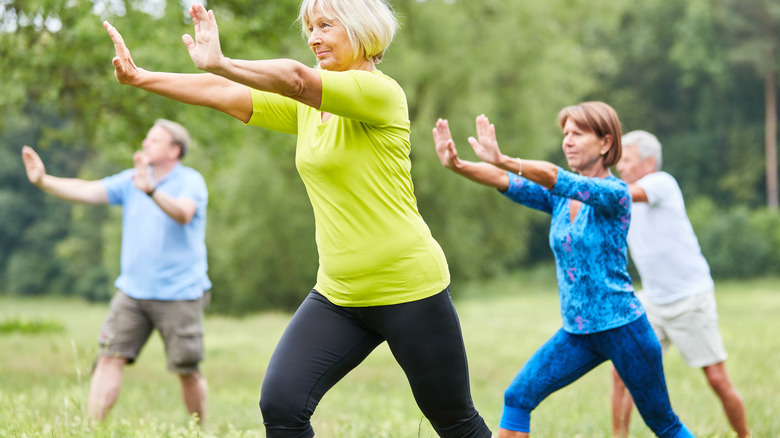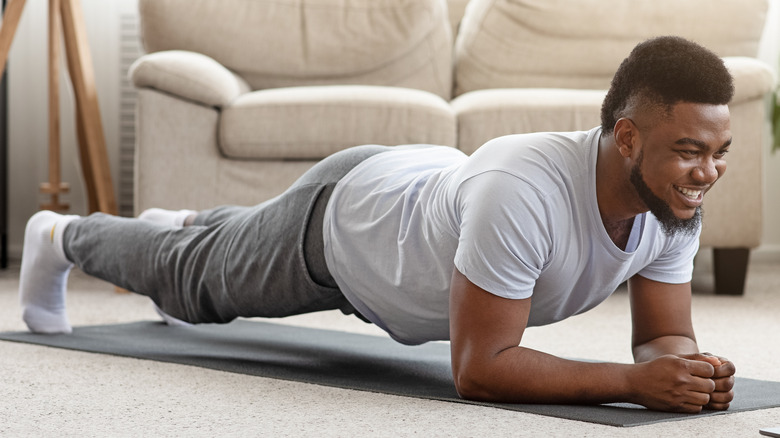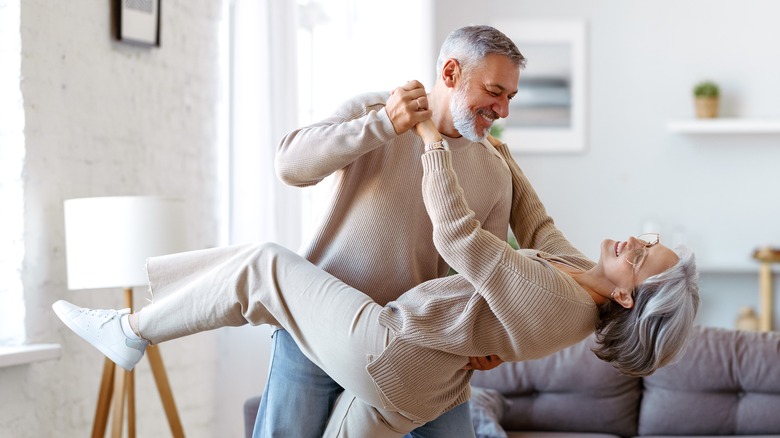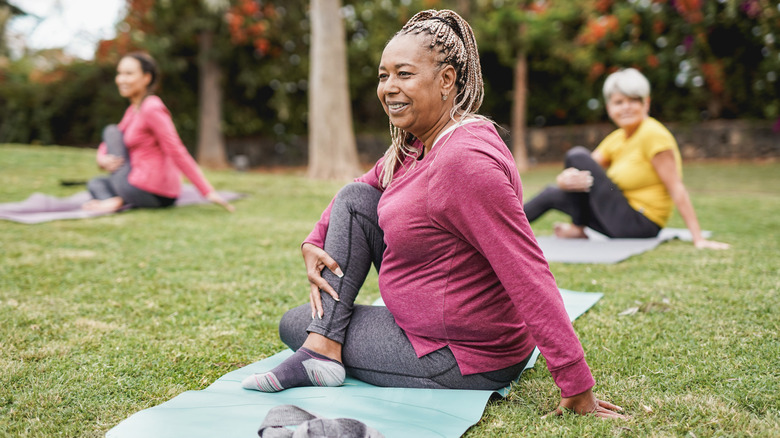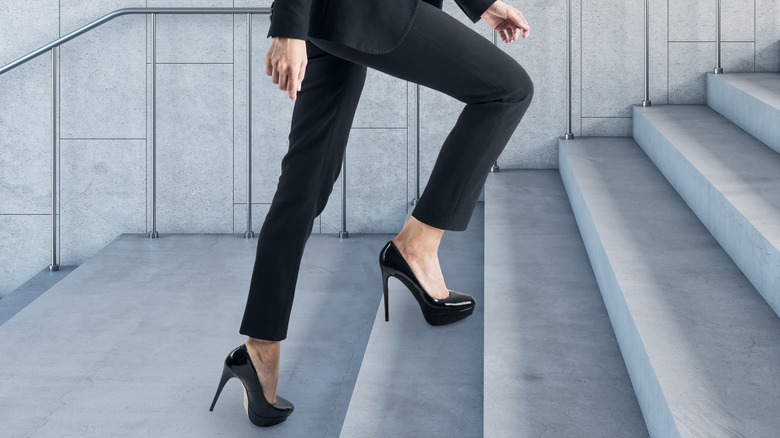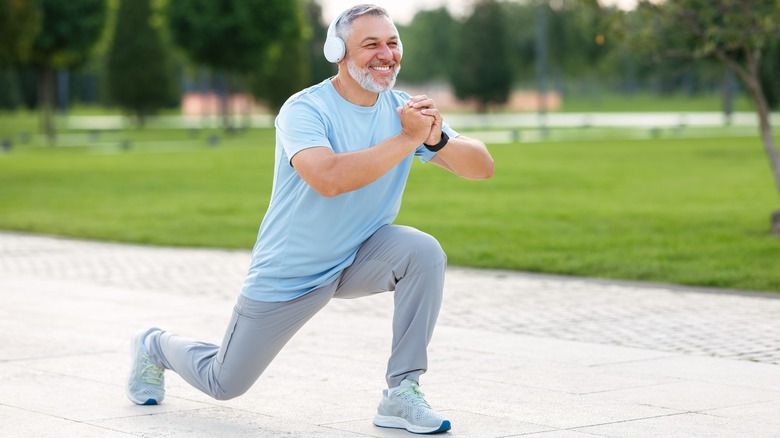The Best Exercises To Try If You Have Osteoporosis
Osteoporosis is a highly common condition, and chances are, you know someone who experiences it. The disease impacts over 200 million people across the world every day, and approximately a third of all women and a fifth of all men worldwide will have an osteoporosis-related fracture at some point, says research published in the European Journal of Rheumatology.
The lower bone mass and weaker bone structure that are typical of osteoporosis can cause people to have to reassess how they live on a day-to-day level, especially when it comes to how they manage their exercise regimen. Picking the wrong form of exercise, or anything too intense, could result in more complications from the condition.
But there's good news on the horizon. There are plenty of exercises that are well suited for people who have osteoporosis and can provide a workout that will be less risky for the bones. And in some cases, the type of exercise you pick could even help to preserve your bone strength and reduce the chances of an injury. We've got the lowdown right here on all of the best exercises to try if you have osteoporosis.
Why is exercise important for people with osteoporosis?
If you have osteoporosis, it might be tempting to try and limit your movement, to lessen the risk of bones breaking or other complications from your condition. But exercising with osteoporosis is not only okay to do, but recommended, as WebMD states. We typically think of exercise as a way to strengthen our muscles, but it also allows us to generate better bone strength and mass, too. Weight-bearing exercise is especially useful for this, and resistance exercises can also build more bone density, thanks to the involvement of your bones in the movements.
Exercises that focus on better flexibility, like stretching and yoga, can also be great choices for people with osteoporosis, thanks to their benefits to your joint movement. It's important to make sure that any exercise you're getting is regular, with five sessions of good-intensity exercise, lasting for a minimum of half an hour, recommended by health professionals. Before you start any new exercise regime, though, it's very important to check with your doctor about the potential impact it could have on your condition.
Walking with osteoporosis may help maintain bone density
Sometimes, the simplest forms of exercise are the best. And if you have osteoporosis, walking regularly could be a safe and effective form of exercise, both in providing the general health benefits that working out provides and more specific benefits for your bones.
A study published in The American Journal of Medicine found that walking just one mile daily could lead to higher overall bone density. A weight-bearing exercise, walking could provide improvements not only in the bone density of your legs, but also all over your body.
And if you want to add something a little extra, try adding some weight to your walk. Using weights during a walk, either through wrist or ankle weights or a weighted vest, can be a popular option for folks who want additional resistance, and can be useful to build extra bone mass and density, says Medical News Today. Just make sure that you're adding weight really gently if you have osteoporosis, to ensure that you don't overload yourself. Additionally, make sure that any weights you add are well fitted to your body and don't compromise your motion in any way.
Jumping rope is a great choice
When was the last time you busted out the jump rope? If it's been on the shelf since you were a kid in the playground, it could be time to blow the cobwebs off and get hopping.
Jumping rope is an effective exercise for people with osteoporosis, thanks to its potential to strengthen bones, as Medical News Today says. This is all because of the impact that occurs when you land after each jump, which prompts the production of additional bone tissue and improves their robustness. Your bone mineral density could even increase by several percent after following a jump rope regimen, as evidenced by a study published in the Journal of Bone and Mineral Metabolism which looked at the impact of jumping rope twice a day for almost six months.
However, as with any exercise, if you have osteoporosis, it's vital to be careful when jumping rope. If your balance is affected by your condition, you may want to give jumping rope a miss, as it could increase your risk of falling and potentially injuring yourself. It's also important to consult a doctor as to whether your bones can sustain the continuous impact of jumping that this exercise requires.
For lower-intensity exercise, try yoga
While a lot of emphasis is placed on more typical weight-bearing exercises when you have osteoporosis, other workouts can be just as helpful in strengthening the bones.
Yoga is a gentle way to keep your body moving with your condition, and encourages good flexibility and mobility, as Healthline discusses. It may also assist you with pain management associated with osteoporosis, make your coordination better, and generally provide a relaxing workout that'll leave you feeling very centered.
Yoga also has weight-bearing elements, and can help to build bone strength just as well as some other forms of exercise. Try incorporating a high plank pose into your routines, which bears weight through your upper body while also strengthening your upper and lower body muscles. Performing a tree pose regularly may also assist with improving posture and balance, and will give your core and back a pretty good workout, too. Try as much as possible to avoid poses or moves that could place stress on your bones and your body — things like backbends, twists, or balances on your hands may not be the best idea for people with osteoporosis.
Swimming is good for more advanced osteoporosis
Swimming may be low on your priority list if you have osteoporosis. Sure, it's a great cardio workout and can be infinitely relaxing, but swimming's not a weight-bearing exercise, so what's the point, right? Well, depending on the progression of your condition, swimming could be the best thing for you. If you have particularly developed osteoporosis symptoms, swimming could deliver a gentle form of exercise that's less dangerous, as Better Health discusses. This could be especially helpful if you're at higher risk of fractures or injury from your condition.
But if your osteoporosis isn't as acute, you might not want to write off swimming just yet. Although the nature of being held up in the water means that bone mineral density (or BMD) may not be as affected by swimming as by other weight-bearing exercises, a study published in BioMed Research International showed that BMD did improve amongst some swimmers. It's worth pointing out, though, that BMD only seemed to be affected for people who swam especially long distances or for longer lengths of time, and for people swimming for less than three hours, it didn't seem to have an impact on their skeletons.
Lifting weights adds resistance to build muscle and bone
Lifting a set of weights regularly has some pretty hefty benefits, with a range of chronic conditions potentially improved by strength training, alongside the obvious benefits of gaining muscle (per the Mayo Clinic). And for people who have osteoporosis, it could be even more useful. When you perform resistance exercises like weight training, bone growth can be prompted thanks to the additional stress being placed on the bone, says WebMD. This then leads to a lower risk of fractures or other issues associated with your osteoporosis.
However, to minimize any risk posed by weight training, it's important to adhere to some key rules. Ensure that you're not overtraining, and that you're giving the muscles you train adequate time to recover, ideally with a full day between hitting the same muscle groups. Don't stick to one muscle group too heavily, too; instead, focus on overall strength. Finally, make sure that you're not jumping to a super-heavy weight straight off the bat. Start with smaller weights, and build up your intensity.
Tai chi is great for your skeleton
You may have a preconceived notion of tai chi as a mild, potentially ineffective exercise. But that's not the case at all. While tai chi certainly seems less effortful at a casual glance, it's a brilliant way to improve muscle definition, flexibility, and stamina, as well as boost your mood and fight against anxiety (per the Mayo Clinic).
And for folks that have osteoporosis, it could be the perfect form of exercise. "There's very strong evidence that tai chi is one of the best weight-bearing exercises to reduce the risk for falls," says Osher Center for Integrative Medicine director Peter Wayne (via Harvard Health Publishing). Tai chi is a form of exercise in which you're bearing significant weight, constantly on your feet, and in motion — and your bones could benefit from it significantly. It also assists in building muscle over your entire body, which aids your stability and lessens the likelihood of falling over. Wayne points toward research that found that practicing tai chi could bring the chance of a fall down by as much as 40% when doing it for only six months.
At-home exercises can load your bones
There's been a revolution when it comes to exercise. People no longer have to get themselves over to a gym when they want to feel the burn; instead, they can simply browse YouTube, unroll their exercise mat, and get a serious workout in the comfort of their own homes. And that shouldn't be any different for people with osteoporosis — you can design your very own workout that's specifically intended to assist in strengthening your bones.
Given that osteoporosis can often present problems in the hips, focusing on moves that benefit the area is a good use of your precious workout time. Stomping could be the ideal move for this, as it encourages bone density growth in your hip area, as the Cleveland Clinic states. Performing exercises that strengthen the muscles in the hip area, like hip leg lifts, can provide further improvements to your balance (per Healthline). Other moves like hamstring curls work the other muscles in your legs and reinforce balance from a different angle. And don't forget to work on your center, too, using gentle moves like ball sits to generate power and heighten balance through your core.
Don't forget about dancing
What is life without a little dancing? Not much, we say. In addition to being a brilliant way to work out, dancing is also just, well, fun. The good news is that for people with osteoporosis, it could be one of the better ways to work out, delivering bone-strengthening benefits in certain parts of the body. A study published in the American Journal of Physical Medicine & Rehabilitation examined the effects of a senior dancing program over a year, specifically looking at its impact on bone health. The researchers found that bone mass in the spine, specifically, was improved.
It's important, though, to be careful about the type of dance you're doing. Impact-heavy modern dance, for example, could put you at increased risk of fractures if you're susceptible to them due to your osteoporosis. Instead, focus on lower-impact dance forms like waltzing, line dancing, or salsa, as Aviva Senior Living suggests. Just make sure that whatever form of dance you choose, it's appropriate to the level of your condition — and most importantly, remember to enjoy yourself!
Gardening delivers gentle, peaceful exercise
Don't underestimate the power of gardening, folks. In addition to the unparalleled ability of regular gardening to create a vista that your neighbors will be endlessly jealous of, gardening can also be a great way to stay fit if you have osteoporosis.
"When you're out in the garden, the fact that you're walking, that you're using instruments, that you're using your body and your muscles in a certain way, it's called weight bearing exercise," says neurosurgeon Deborah Benzil (via the Cleveland Clinic). By holding your body weight up all day as you dig, weed, and cart around your wheelbarrow, you're building bone density and combating the weakening effects of the condition, says Benzil.
And that's before all of the other benefits that gardening can deliver, like improvements to mental health, neurological health, and immunity. Remember, though, that while gardening might seem gentle, it's still a workout, and should be treated as such. Benzil recommends trying to warm up lightly before you head out for your daily gardening work and stretching well once you're done. Focusing on the back area when you do this, which can be particularly impacted by gardening, is a great move, and will help you bounce back next time.
Pilates can provide a low-impact workout
We don't know if anyone's told you before, but Pilates is quite popular. Almost 10 million people practiced the exercise form regularly in 2021 (per Statista), enjoying its low-impact benefits to the body. For people who live with osteoporosis, Pilates could be just the ticket, assisting in keeping bones and muscles strong and healthy in a safe and controlled manner, thereby reducing the risk of falls and injuries (via the Royal Osteoporosis Society).
However, even something as seemingly low-intensity as Pilates should be conducted with care, particularly if you have osteoporosis. The exercise form has an emphasis on movements that involve the spine, and curving or "over-flexing" the spine can create issues for people who have back issues or have experienced fractures. Instead of doing this, make sure you're adapting your movements to keep your spine from becoming overly impacted. Additionally, perform any movements slowly and carefully, focusing on proper form. If you have any doubts about whether a Pilates move is safe to do, consult with your Pilates trainer about potential alternatives.
Simply climbing your stairs may strengthen your bones
Here's the thing, folks. Have you ever noticed that climbing the stairs is actually really hard? That's because, if you think about it, it's a pretty hardcore move. Climbing the stairs involves pulling your entire body weight up, again and again, and involving all of your lower body muscles and your abs to do so (per Axis Active). No wonder it's so tiring.
But here's the other thing: It's very, very good for you, and especially good if you have osteoporosis. A weight-bearing exercise, climbing stairs causes resistance throughout the leg and for your hip and backbones, and this works to build bone mass and density and prevent bone loss, as Princeton Longevity Center says. It also allows you to build serious muscle, gets your heart racing, and can be done in the comfort of your own home. What's not to love?
Be aware, though, that if you're prone to falling, stair climbing can present potential challenges. That's why it's useful to hold on to the handrail at all times for support, trying not to pull yourself up with it, as doing so will lessen the impact of your workout.
Don't underestimate stretching as an exercise
Of all the exercises that are out there, stretching isn't exactly the most glamorous, and tends to take a back seat to the flashier HIIT workouts and Crossfit gyms. But if you have osteoporosis, stretching could be one of the best things you do for your body.
While stretching may not have any specific benefits to your bone strength, what it does very well is loosen up your muscles, as the Cleveland Clinic states. When this is done across your body (and in your back, specifically), it can reduce back pain, improve posture, and thereby lessen the discomfort of osteoporosis and the likelihood of injury.
But don't assume that just because stretching is milder than some workouts, you can simply jump straight into it. Start slowly, and work through your stretches gently, stopping if you feel any pain, says orthopedic physical therapist Jennifer Danzo. Ensure that you're holding each stretch for a good amount of time, to get the most benefit — around 30 seconds for each stretch is ideal. And remember to keep your stretch regime consistent, as regular stretching will give you the best results.
What exercises shouldn't I do?
While there is a range of exercises that are especially well suited for people with osteoporosis, there are also a fair few that aren't. And knowing what to avoid will help you keep your skeleton in good shape for years to come.
High-impact exercises like running are especially important to be wary of — and avoid, if your doctor recommends doing so — as the weakening of bones that osteoporosis causes can put you at risk of fracture when pounding the pavement (per Creaky Joints). Certain jumping exercises may also be wise to avoid, depending on the severity of your condition, as well as exercises that might cause you to fall over more often (like skiing).
It's also vital to stay away from exercises that might stress your spine, as certain muscle-strengthening moves do. When your bones are weaker, "and you put a lot of force or pressure into the front of the spine — such as in a sit-up or toe touch — it increases your risk of a compression fracture," warns physical therapist Karen Kemmis. Workouts that involve a large amount of twisting through the spine, like golfing or tennis, can also stress the vertebrae and increase fracture risk.

